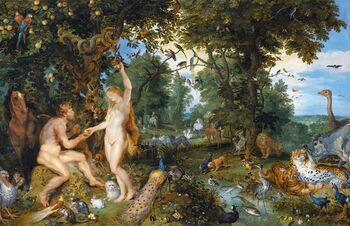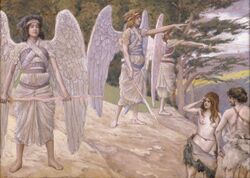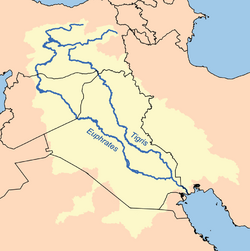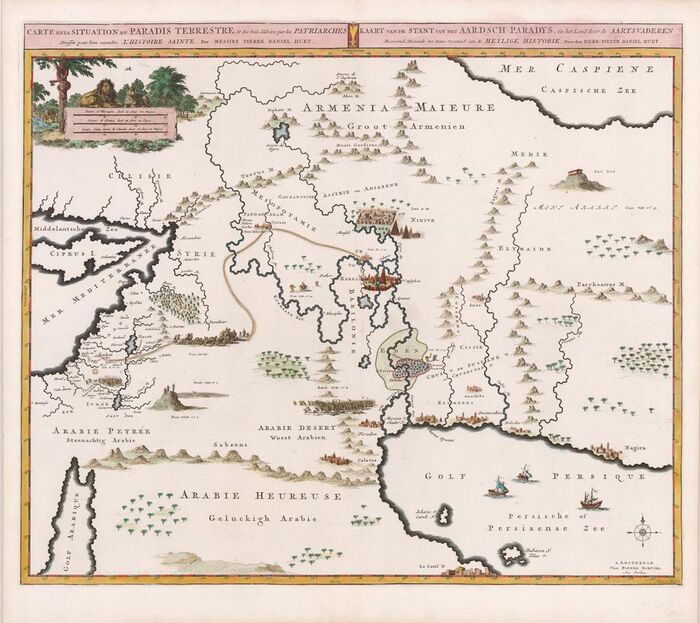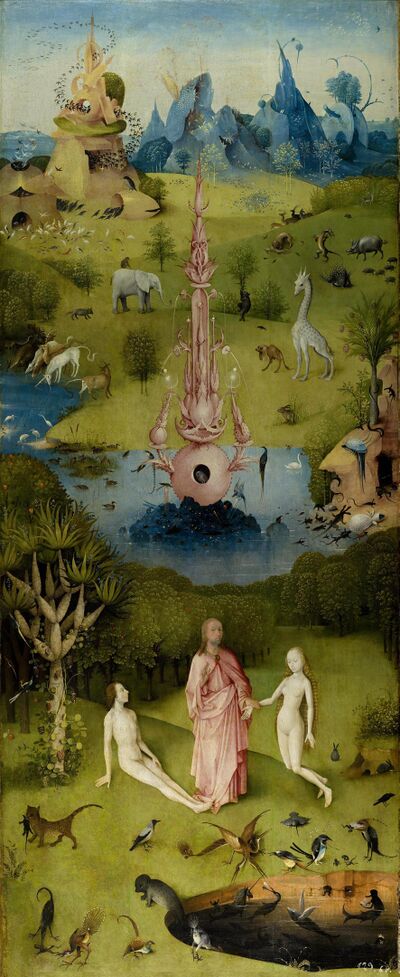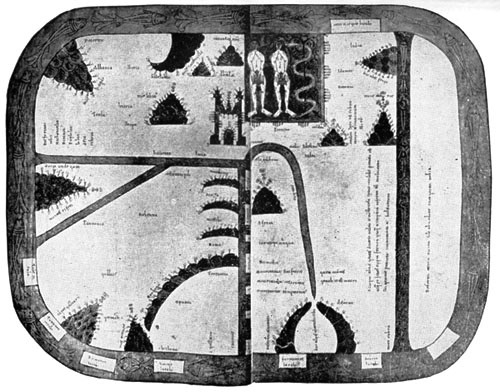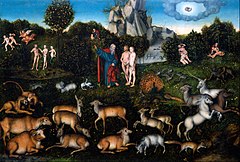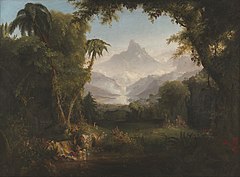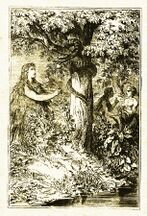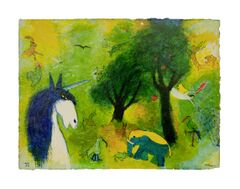Religion:Garden of Eden
In Abrahamic religions, the Garden of Eden (Biblical Hebrew: גַּן־עֵדֶן, romanized: gan-ʿĒḏen; Greek: Εδέμ; Latin: Paradisus) or Garden of God (גַּן־יְהֹוֶה, gan-YHWH and גַן־אֱלֹהִים, gan-Elohim), also called the Terrestrial Paradise, is the biblical paradise described in Genesis 2–3 and Ezekiel 28 and 31.[1][2]
The location of Eden is described in the Book of Genesis as the source of four tributaries. Various suggestions have been made for its location:[3] at the head of the Persian Gulf, in southern Mesopotamia where the Tigris and Euphrates rivers run into the sea;[4] and in Armenia.[5][6][7] Others theorize that Eden was the entire Fertile Crescent[8] or a region of "considerable size" in Mesopotamia, where its native inhabitants still exist in cities such as Telassar.[9][10]
Like the Genesis flood narrative, the Genesis creation narrative and the account of the Tower of Babel, the story of Eden echoes the Mesopotamian myth of a king, as a primordial man, who is placed in a divine garden to guard the tree of life.[11] Scholars note Canaanite parallels[12] and tend to think that the Eden narrative drew from the aspects of the Solomon’s Temple and Jerusalem[13][14] and that the garden was modeled on Persian royal gardens.[15] Mentions of Eden are also made in the Bible elsewhere in Genesis,[16] in Isaiah 51:3,[17] Ezekiel 36:35,[18] and Joel 2:3;[19] Zechariah 14 and Ezekiel 47 use paradisical imagery without naming Eden.[20]
The name derives from the Akkadian edinnu, from a Sumerian word edin meaning 'plain' or 'steppe', closely related to an Aramaic root word meaning 'fruitful, well-watered'.[2] Another interpretation associates the name with a Hebrew word for 'pleasure'; thus the Vulgate reads paradisum voluptatis in Genesis 2:8, and the Douay–Rheims Bible, following, has the wording "And the Lord God had planted a paradise of pleasure".[21]
Biblical narratives
Genesis
The second part of the Genesis creation narrative, Genesis 2:4–3:24, opens with YHWH-Elohim (translated here "the LORD God")[lower-alpha 1] creating the first man (Adam), whom he placed in a garden that he planted "eastward in Eden":[22]
And out of the ground made the Lord God to grow every tree that is pleasant to the sight, and good for food; the tree of life also in the midst of the garden, and the tree of knowledge of good and evil.
The man was free to eat from any tree in the garden except the tree of the knowledge of good and evil, which was taboo. Last of all, God made a woman (Eve) from a rib of the man to be a companion for the man. In Genesis 3, the man and the woman were seduced by the serpent into eating the forbidden fruit, and they were expelled from the garden to prevent them from eating of the tree of life, and thus living forever. Cherubim were placed east of the garden, "and a flaming sword which turned every way, to guard the way of the tree of life".[23]
Genesis 2:10–14[24] lists four rivers in association with the garden of Eden: Pishon, Gihon, Hiddekel (the Tigris), and Phirat (the Euphrates). It also refers to the land of Cush—translated/interpreted as Ethiopia, but thought by some to equate to Cossaea, a Greek name for the land of the Kassites.[25] These lands lie north of Elam, immediately to the east of ancient Babylon, which, unlike Ethiopia, does lie within the region being described.[26] In Antiquities of the Jews, the first-century Jewish historian Josephus identifies the Pishon as what "the Greeks called Ganges" and the Geon (Gehon) as the Nile.[27]
Ezekiel
In Ezekiel 28:12–19,[28] the prophet Ezekiel the "son of man" sets down God's word against the king of Tyre: the king was the "seal of perfection", adorned with precious stones from the day of his creation, placed by God in the garden of Eden on the holy mountain as a guardian cherub. However, the king sinned through wickedness and violence, and so he was driven out of the garden and thrown to the earth, where now he is consumed by God's fire: "All those who knew you in the nations are appalled at you, you have come to a horrible end and will be no more." (Ezekiel 28:19).
Proposed locations
The location of Eden is described in Genesis 2:10–14:[29]
And a river went out of Eden to water the garden; and from thence it was parted, and became four heads. The name of the first is Pishon; that is it which compasseth the whole land of Havilah, where there is gold; and the gold of that land is good; there is bdellium and the onyx stone. And the name of the second river is Gihon; the same is it that compasseth the whole land of Cush. And the name of the third river is Tigris; that is it which goeth toward the east of Asshur. And the fourth river is the Euphrates.
Suggestions for the location of Eden include[3][30] the head of the Persian Gulf, as argued by Juris Zarins, in southern Mesopotamia where the Tigris and Euphrates rivers run into the sea;[4] and in the Armenian Highlands or Armenian National Plateau.[5][31][6][7] British archaeologist David Rohl locates it in Iran, and in the vicinity of Tabriz, but this suggestion has not been adopted by mainstream academia.[32]
Others theorize that Eden was merely a region of "considerable size" in Mesopotamia, where its native inhabitants still exist in cities such as Telassar, based on verses such as Isaiah 38:17.[9][10] Or that it encompassed the entire Fertile Crescent.[8]
According to Terje Stordalen, the Book of Ezekiel places Eden in Lebanon.[33] "[I]t appears that the Lebanon is an alternative placement in Phoenician myth (as in Ez 28,13, III.48) of the Garden of Eden",[34] and there are connections between paradise, the Garden of Eden and the forests of Lebanon (possibly used symbolically) within prophetic writings.[35] Edward Lipinski and Peter Kyle McCarter have suggested that the garden of the gods, the oldest Sumerian analog of the Garden of Eden, relates to a mountain sanctuary in the Lebanon and Anti-Lebanon ranges.[36]
Some religious groups have believed the location of the garden to be local to them, outside of the Middle East. Some early leaders of Mormonism held that it was located in Jackson County, Missouri.[37] The 20th-century Panacea Society believed it was located at the site of their home town of Bedford, England,[38] while preacher Elvy E. Callaway believed it was on the Apalachicola River in Florida, near the town of Bristol.[39] Some suggested that the location is in Jerusalem.[40]
On his third voyage to the Americas in 1498, Christopher Columbus thought he may have reached the Earthly Paradise upon first seeing the South American mainland.[41]
In his book The Creation, the Garden of Eden and the Origin of the Chinese, Tse Tsan-tai argued that the Garden of Eden was located in modern-day Xinjiang.[42]
Parallel concepts
A number of parallel concepts to the biblical Garden of Eden exist in various other religions and mythologies. Dilmun in the Sumerian story of Enki and Ninhursag is a paradisaical abode[43] of the immortals, where sickness and death were unknown.[44] The garden of the Hesperides in Greek mythology was also somewhat similar to the Jewish concept of the Garden of Eden, and by the 16th century a larger intellectual association was made in the Cranach painting.
The word "paradise" entered English from the French paradis, inherited from the Latin paradisus, paradisum, from the Greek parádeisos (παράδεισος). The Greek, in turn, was derived from an Old Iranian form, itself from the Proto-Iranian *parādaiĵah-, 'walled enclosure', which was derived from the Old Persian 𐎱𐎼𐎭𐎹𐎭𐎠𐎶 (p-r-d-y-d-a-m, /paridaidam/, whence from the Avestan 𐬞𐬀𐬌𐬭𐬌⸱𐬛𐬀𐬉𐬰𐬀, pairi-daêza-. The literal meaning of this word is 'walled (enclosure)', from pairi- 'around' (cognate with the Greek περί and the English peri-, of identical meaning), and -diz, "to make, form (a wall), build" (cognate with the Greek τεῖχος, 'wall'). The word's etymology is ultimately derived from a Proto-Indo-European root, *dheigʷ, 'to stick and set up (a wall)', and *per, 'around'.
By the 6th/5th century BCE, the Old Iranian word had been borrowed into the Akkadian language as pardesu, 'domain'. It subsequently came to indicate the expansive walled gardens of the First Persian Empire, and was subsequently borrowed into a number of languages; into Greek as παράδεισος (parádeisos), 'park for animals', in Anabasis, the most famous work of the early 4th century BCE Athenian Xenophon; into Aramaic as pardaysa, 'royal park'; and into Hebrew as pardes (פַּרְדֵּס), 'orchard', appearing thrice in the Tanakh: in the Song of Solomon (4:13), Ecclesiastes (2:5), and Nehemiah (2:8).
In the Septuagint (3rd–1st centuries BCE), the Greek παράδεισος (parádeisos) was used to translate both the Hebrew פרדס (pardes) and גן (gan), meaning 'garden' (e.g. (Genesis 2:8, Ezekiel 28:13): it is from this usage that the use of paradise to refer to the Garden of Eden derives. The same usage also appears in Arabic and in the Quran as firdaws فردوس.
The idea of a walled enclosure was not preserved in most Iranian usage, and generally came to refer to a plantation or other cultivated area, not necessarily walled. For example, the Old Iranian word survives as pardis in New Persian, as well as its derivative pālīz (or jālīz), which denotes a vegetable patch.
The word pardes occurs three times in the Hebrew Bible, but always in contexts other than a connection with Eden: in the Song of Solomon 4:13: "Thy plants are an orchard (pardes) of pomegranates, with pleasant fruits; camphire, with spikenard"; Ecclesiastes 2:5: "I made me gardens and orchards (pardes), and I planted trees in them of all kind of fruits"; and in Nehemiah 2:8: "And a letter unto Asaph the keeper of the king's orchard (pardes), that he may give me timber to make beams for the gates of the palace which appertained to the house, and for the wall of the city". In these examples, pardes clearly means 'orchard' or 'park', but in the apocalyptic literature and in the Talmud paradise gains its associations with the Garden of Eden and its heavenly prototype, and in the New Testament paradise becomes the realm of the blessed (as opposed to the realm of the cursed) among those who have already died, with literary Hellenistic influences.
Other views
Jewish eschatology
In the Talmud and the Jewish Kabbalah,[45] the scholars agree that there are two types of spiritual places called "Garden in Eden". The first is rather terrestrial, of abundant fertility and luxuriant vegetation, known as the "lower Gan Eden" (gan meaning garden). The second is envisioned as being celestial, the habitation of righteous, Jewish and non-Jewish, immortal souls, known as the "higher Gan Eden". The rabbis differentiate between Gan and Eden. Adam is said to have dwelt only in the Gan, whereas Eden is said never to be witnessed by any mortal eye.[45]
According to Jewish eschatology,[46] the higher Gan Eden is called the "Garden of Righteousness". It has been created since the beginning of the world, and will appear gloriously at the end of time. The righteous dwelling there will enjoy the sight of the heavenly chayot carrying the throne of God. Each of the righteous will walk with God, who will lead them in a dance. Its Jewish and non-Jewish inhabitants are "clothed with garments of light and eternal life, and eat of the tree of life" (Enoch 58,3) near to God and his anointed ones.[46] This Jewish rabbinical concept of a higher Gan Eden is opposed by the Hebrew terms gehinnom and sheol, figurative names for the place of spiritual purification for the wicked dead in Judaism, a place envisioned as being at the greatest possible distance from heaven.[citation needed]
Some modern Orthodox Jews believe that history will complete itself and the ultimate destination will be when all mankind returns to the Garden of Eden.[47]
Legends of the Jews
In the 1909 book Legends of the Jews, Louis Ginzberg compiled Jewish legends found in rabbinic literature. Among the legends are ones about the two Gardens of Eden. Beyond Paradise is the higher Gan Eden, where God is enthroned and explains the Torah to its inhabitants. The higher Gan Eden contains three hundred and ten worlds and is divided into seven compartments. The compartments are not described, though it is implied that each compartment is greater than the previous one and is joined based on one's merit. The first compartment is for Jewish martyrs, the second for those who drowned, the third for "Rabbi Johanan ben Zakkai and his disciples," the fourth for those whom the cloud of glory carried off, the fifth for penitents, the sixth for youths who have never sinned; and the seventh for the poor who lived decently and studied the Torah.[48]
In chapter two, Legends of the Jews gives a brief description of the lower Gan Eden. The tree of knowledge is a hedge around the tree of life, which is so vast that "it would take a man five hundred years to traverse a distance equal to the diameter of the trunk". From beneath the trees flow all the world's waters in the form of four rivers: Tigris, Nile, Euphrates, and Ganges. After the fall of man, the world was no longer irrigated by this water. While in the garden, though, Adam and Eve were served meat dishes by angels and the animals of the world understood human language, respected mankind as God's image, and feared Adam and Eve. When one dies, one's soul must pass through the lower Gan Eden in order to reach the higher Gan Eden. The way to the garden is the Cave of Machpelah that Adam guards. The cave leads to the gate of the garden, guarded by a cherub with a flaming sword. If a soul is unworthy of entering, the sword annihilates it. Within the garden is a pillar of fire and smoke that extends to the higher Gan Eden, which the soul must climb in order to reach the higher Gan Eden.[48]
Islamic view
The term jannāt ʿadni ("Gardens of Eden" or "Gardens of Perpetual Residence") is used in the Quran for the destination of the righteous. There are several mentions of "the Garden" in the Quran,[49] while the Garden of Eden, without the word ʿadn,[50] is commonly the fourth layer of the Islamic heaven and not necessarily thought as the dwelling place of Adam.[51] The Quran refers frequently over various Surah about the first abode of Adam and Hawwa (Eve), including surat Sad, which features 18 verses on the subject (38:71–88), surat al-Baqara, surat al-A'raf, and surat al-Hijr although sometimes without mentioning the location. The narrative mainly surrounds the resulting expulsion of Hawwa and Adam after they were tempted by Iblis (Satan). Despite the biblical account, the Quran mentions only one tree in Eden, the tree of immortality, from which God specifically forbade Adam and Eve. Some exegesis added an account, about Satan, disguised as a serpent to enter the Garden, repeatedly told Adam to eat from the tree, and eventually both Adam and Eve did so, resulting in disobeying God.[52] These stories are also featured in the hadith collections, including al-Tabari.[53]
- Quranic scripture of story
Quranic verses Q. 2:35–38, are believed to tell the story of Adam disobeying God's command and eating the Forbidden Fruit, and of God ordered him out of the Garden. One translation (the Clear Quran) that indicates that the Garden of Eden was in Heaven goes:
- We cautioned, "O Adam! Live with your wife in Paradise (lit. "the Garden") and eat as freely as you please, but do not approach this tree, or else you will be wrongdoers." (2:35)
- But Satan deceived them—leading to their fall from the [blissful] state they were in,1 and We said, "Descend from the heavens [to the earth] as enemies to each other.2 You will find in the earth a residence and provision for your appointed stay." (2:36)
- Then Adam was inspired with words ˹of prayer˺ by his Lord, so He accepted his repentance. Surely He is the Accepter of Repentance, Most Merciful. (2:37)
- We said, "Descend all of you! Then when guidance comes to you from Me, whoever follows it, there will be no fear for them, nor will they grieve. (2:38) [54]
- Location
Quranic verses describe Adam was being expelled from al-Jannah, "the garden", which is the commonly used word for paradise in Islam. However, according to Ibn Kathir (d. 1372) and Ar-Razi (d. 1209), (exegetes of the Quran), four interpretations of the location of the garden prevailed among early Muslims:
- that the garden was Paradise itself,
- that it was a separate garden created especially for Adam and Eve,
- that it was located on Earth,
- that it was best for the Muslims not to be concerned with the location of the garden.[55]
According to T. O. Shanavas however, contextual analysis of Quranic verses suggests the Garden of Eden could not have been in Paradise and must have been on earth. (For example, a sahih hadith reports Muhammad said: "Allah says: I have prepared for my righteous servants that which has neither been seen by eyes, nor heard by ears, nor ever conceived by any man." i.e. no man has ever seen Paradise. Since Adam was a man, he could not have seen paradise, therefore he could not have lived there.)[55]
- Doctrine of "The Fall of Man"
Islamic exegesis does not regard Adam and Eve's expulsion from paradise as punishment for disobedience or a result from abused free will on their part.[56]:{{{1}}} Instead, ibn Qayyim al-Jawziyya (1292–1350) writes, God's wisdom (ḥikma) destined humanity to leave the garden and settle on earth. This is because God wants to unfold the full range of his attributes.[56]:{{{1}}} If humans were not to live on earth, God could not express his love, forgiveness, and power to his creation.[56] Further, if humans were not to experience suffering, they could neither long for paradise nor appreciate its delights.[56] Khwaja Abdullah Ansari (1006–1088) describes Adam and Eve's expulsion as ultimately caused by God.[57]:{{{1}}} Nonetheless, despite the paradoxical notion that man has no choice but to comply to God's will, this does not mean that humans should not blame themselves for their "sin" of complying.[57]:{{{1}}} This is exemplified by Adam and Eve in the Quran (Q. 7:23 "Our Lord! We have wronged ourselves. If You do not forgive us and have mercy on us, we will certainly be losers"), in contrast to Iblis (Satan) who blames God for leading him astray (Q. 15:37).[57]
Latter Day Saints
Followers of the Latter Day Saint movement believe that after Adam and Eve were expelled from the Garden of Eden they resided in a place known as Adam-ondi-Ahman, located in present-day Daviess County, Missouri. It is recorded in the Doctrine and Covenants that Adam blessed his posterity there and that he will return to that place at the time of the final judgment[58][59] in fulfillment of a prophecy set forth in the Bible.[60]
Numerous early leaders of the Church, including Brigham Young, Heber C. Kimball, and George Q. Cannon, taught that the Garden of Eden itself was located in nearby Jackson County,[37] but there are no surviving first-hand accounts of that doctrine being taught by Joseph Smith himself. LDS doctrine is unclear as to the exact location of the Garden of Eden, but tradition among Latter-Day Saints places it somewhere in the vicinity of Adam-ondi-Ahman, or in Jackson County.[61][62]
Gnosticism
The 2nd-century Gnostic teacher Justin held that there were three original divinities, a transcendental being called the Good, an intermediate male figure known as Elohim and Eden who is an Earth-mother. The world is created from the love of Elohim and Eden, but evil later is brought into the universe when Elohim learns of the existence of the Good above him and ascends trying to reach it.[63]
Art and literature
Art
One of oldest depictions of Garden of Eden is made in Byzantine style in Ravenna, while the city was still under Byzantine control. A preserved blue mosaic is part of the mausoleum of Galla Placidia. Circular motifs represent flowers of the garden of Eden. The Garden of Eden motifs most frequently portrayed in illuminated manuscripts and paintings are the "Sleep of Adam" ("Creation of Eve"), the "Temptation of Eve" by the Serpent, the "Fall of Man" where Adam takes the fruit, and the "Expulsion". The idyll of "Naming Day in Eden" was less often depicted. Michelangelo depicted a scene at the Garden of Eden on the Sistine Chapel ceiling.
After wandering through the Garden of Eden, Eve takes the forbidden fruit while Lilith speaks to Adam (by Carl Poellath, c. 1886)
Literature
For many medieval writers, the image of the Garden of Eden also creates a location for human love and sexuality, often associated with the classic and medieval trope of the locus amoenus.[64]
In the Divine Comedy, Dante Alighieri places the Garden at the top of Mt. Purgatory. Dante, the pilgrim, emerges into the Garden of Eden in Canto 28 of Purgatorio. Here he is told that God gave the Garden of Eden to man "in earnest, or as a pledge of eternal life," but man was only able to dwell there for a short time because he soon fell from grace. In the poem, the Garden of Eden is both human and divine: while it is located on earth at the top of Mt. Purgatory, it also serves as the gateway to the heavens.[65]
Much of Milton's Paradise Lost occurs in the Garden of Eden.
The first act of Arthur Miller's 1972 play Creation of the World and Other Business is set in the Garden of Eden.
See also
- Epic of Gilgamesh
- Golden Age
- Heaven in Judaism
- Hesperides
- Jannah
- Mazandaran (Shahnameh)
- Persian gardens
- Purgatorio
- Sacred garden
- The Summerland
- Tamoanchan
- Utopia
- Atemporal fall
Notes
References
- ↑ Metzger, Bruce Manning; Coogan, Michael D (2004). The Oxford Guide To People And Places Of The Bible. Oxford University Press. p. 62. ISBN 978-0-19-517610-0. https://books.google.com/books?id=amlXOOaSuLMC. Retrieved 22 December 2012.
- ↑ 2.0 2.1 Cohen 2011, pp. 228–229.
- ↑ 3.0 3.1 Wilensky-Lanford, Brook (2012). Paradise Lust: Searching for the Garden of Eden. Grove Press. ISBN 9780802145840. https://archive.org/details/paradiselustsear00wile. "paradise lust."
- ↑ 4.0 4.1 Hamblin, Dora Jane (May 1987). "Has the Garden of Eden been located at last? (Dead Link)". Smithsonian 18 (2). http://www.theeffect.org/resources/articles/pdfsetc/Eden.pdf. Retrieved 8 January 2014.
- ↑ 5.0 5.1 Zevit, Ziony. What Really Happened in the Garden of Eden? 2013. Yale University Press, p. 111. ISBN 9780300178692
- ↑ 6.0 6.1 Duncan, Joseph E. Milton's Earthly Paradise: A Historical Study of Eden. 1972. University Of Minnesota Press, pp. 96, 212. ISBN 9780816606337
- ↑ 7.0 7.1 Scafi, Alessandro. Return to the Sources: Paradise in Armenia, in: Mapping Paradise: A History of Heaven on Earth. 2006. London, England and Chicago, Illinois: British Library and University of Chicago Press, pp. 317–322. ISBN 9780226735597.
- ↑ 8.0 8.1 Mark, Joshua J. (March 28, 2018). "Fertile Crescent". https://www.worldhistory.org/Fertile_Crescent/.
- ↑ 9.0 9.1 "Telassar in the International Standard Bible Encyclopedia". http://www.internationalstandardbible.com/T/telassar.html.
- ↑ 10.0 10.1 "Isaiah 37: Barnes Commentary". 2023. https://biblehub.com/commentaries/barnes/isaiah/37.htm.
- ↑ Davidson 1973, p. 33.
- ↑ Korpel, Marjo C.A.; de Moor, Johannes C. Adam, Eve, and the Devil: A New Beginning (Hebrew Bible Monographs. Sheffield Phoenix Press Ltd. 2014.)
- ↑ JERUSALEM AND THE GARDEN OF EDEN. Lawrence E. Stager and לורנס א' סטגר. Eretz-Israel: Archaeological, Historical and Geographical Studies / FRANK MOORE CROSS VOLUME. 1999. pp. 183-194 (12 pages). Israel Exploration Society
- ↑ The Garden of Eden as an Israelite Sacred Place. Seung Il Kang. Theology Today Volume 77, Issue 1 https://doi.org/10.1177/0040573617731712
- ↑ Liverani, Mario. Israel's History and the History of Israel, Routledge, 2007, p. 238. “[R]oyal gardens are the model for the ‘garden of Eden’ where the biblical story of Adam and Eve is set (Gen. 2.4–3.24). The word paradise (Heb. pardēs, Bab. pardēsu ‘park’) is of Persian origin (pairidaēza ‘enclosure’), and the Persians were responsible for the spread of this kind of enclosed garden. Thus, the Eden narrative should be assigned to the Babylonia of the Persian age.”
- ↑ Genesis 13:10.
- ↑ Isaiah 51:3.
- ↑ Ezekiel 36:35.
- ↑ Joel 2:3.
- ↑ Tigchelaar 1999, p. 37.
- ↑ "Latin Vulgate Bible with Douay–Rheims and King James Version Side-by-Side+Complete Sayings of Jesus Christ". http://www.latinvulgate.com/lv/verse.aspx?t=0&b=1&c=2.
- ↑ Levenson 2004, p. 13, "The root of Eden denotes fertility. Where the wondrously fertile gard was thought to have been located (if a realistic location was ever conceived) is unclear. The Tigris and Euphrates are the two great rivers of the Mesopotamia (now found in modern Iraq). But the Piston is unidentified, and the only Gihon in the Bible is a spring in Jerusalem (1 Kings 1:33, 38)."
- ↑ Genesis 3:24
- ↑ Genesis 2:10–14
- ↑ "The Jewish Quarterly Review". The Jewish Quarterly Review (University of Pennsylvania Press) 64–65: 132. 1973. ISSN 1553-0604. https://books.google.com/books?id=me8sAAAAIAAJ&q=Cossaea. Retrieved 2014-02-19. "...as Cossaea, the country of the Kassites in Mesopotamia [...]".
- ↑ Speiser 1994, p. 38.
- ↑ Josephus, Antiquities of the Jews. Book I, Chapter 1, Section 3.
- ↑ Ezekiel 28:12–19.
- ↑ Genesis 2:10–14.
- ↑ Carol A. Hill, The Garden of Eden: A Modern Landscape' Perspectives on Science and Christian Faith 52 [March 2000]: 31–46 https://www.asa3.org/ASA/PSCF/2000/PSCF3-00Hill.html
- ↑ Day, John. Yahweh and the Gods and Goddesses of Canaan. 2002. Sheffield Academic Press, p. 30. ISBN 9780826468307
- ↑ Cline, Eric H. (2007). From Eden to Exile: Unraveling Mysteries of the Bible. National Geographic. p. 10. ISBN 978-1-4262-0084-7. https://books.google.com/books?id=bJW-zhffwk4C&q=From+Eden+to+Exile%3A+Unraveling+Mysteries+of+the+Bible.
- ↑ Stordalen 2000, p. 164.
- ↑ Brown 2001, p. 138.
- ↑ Swarup 2006, p. 185.
- ↑ Smith 2009, p. 61.
- ↑ 37.0 37.1 "The location of the Garden of Eden – FAIR". https://www.fairlatterdaysaints.org/answers/Joseph_Smith/Garden_of_Eden_in_Missouri.
- ↑ Shaw, Jane (2012). Octavia, Daughter of God. Random House. pp. 119. ISBN 9781446484272.
- ↑ Gloria Jahoda, The Other Florida, chap. 4, "The Garden of Eden." ISBN 9780912451046.
- ↑ "Jerusalem as Eden". 24 August 2015. https://www.baslibrary.org/biblical-archaeology-review/26/3/2.
- ↑ Bergreen, Lawrence (2011). Columbus: The Four Voyages, 1493–1504. Penguin Group US. p. 236. ISBN 978-1101544327. https://books.google.com/books?id=3Dyhtkk4VQcC.
- ↑ "The Garden of Eden – in China?" (in en-US). 2012-10-02. https://bigthink.com/strange-maps/583-east-is-eden-adam-and-eves-chinese-garden/.
- ↑ Mathews 1996, p. 96.
- ↑ Cohen 2011, p. 229.
- ↑ 45.0 45.1 "EDEN, GARDEN OF – JewishEncyclopedia.com". https://www.jewishencyclopedia.com/articles/5428-eden-garden-of.
- ↑ 46.0 46.1 "ESCHATOLOGY – JewishEncyclopedia.com". https://www.jewishencyclopedia.com/articles/5849-eschatology.
- ↑ "End of Days". Aish. 11 January 2000. http://www.aish.com/ci/a/48925077.html.
- ↑ 48.0 48.1 "Chapter I: The Creation of the World". https://sacred-texts.com/jud/loj/loj103.htm.
- ↑ Qur'an, 2:35, 7:19, 20:117, 61:12.
- ↑ See list of occurrences.
- ↑ Patrick Hughes, Thomas Patrick Hughes Dictionary of Islam, Asian Educational Services 1995 ISBN:978-8-120-60672-2 p. 133.
- ↑ Leaman, Oliver The Quran, an encyclopedia 2006, p. 11.
- ↑ Wheeler, Brannon. Mecca and Eden: ritual, relics, and territory in Islam 2006, p. 16.
- ↑ Al-Bakarah, verses 35-8 translation: Dr. Mustafa Khattab, the Clear Quran. from Quran.com
- ↑ 55.0 55.1 Shanavas, T. O. (September 6, 2019). "The Garden of Eden: An Earthly or Heavenly Garden? (from: Shanavas, T. O. (2005). Islamic Theory of Evolution: The Missing Link between Darwin and the Origin of Species. (p. 161–168).)". http://www.islamicweblibrary.com/2019/09/06/the-garden-of-eden/.
- ↑ 56.0 56.1 56.2 56.3 Lange, Christian (2016). Paradise and Hell in Islamic Traditions. Cambridge, United Kingdom: Cambridge University Press. ISBN 978-0-521-50637-3.
- ↑ 57.0 57.1 57.2 Awn, Peter J. (1983). "The Ethical Concerns of Classical Sufism". The Journal of Religious Ethics 11 (2): 240–263. ISSN 0384-9694. https://www.jstor.org/stable/40017708.
- ↑ "Doctrine and Covenants 107:53". https://www.churchofjesuschrist.org/study/scriptures/dc-testament/dc/107.53?lang=eng.
- ↑ "Doctrine and Covenants 116:1". https://www.churchofjesuschrist.org/study/scriptures/dc-testament/dc/116.1?lang=eng.
- ↑ "Daniel 7:13–14, 22". https://www.churchofjesuschrist.org/study/scriptures/ot/dan/7.13.13-14,22?lang=eng.
- ↑ "I Have a Question" (in en-us). pp. 54–55. https://www.churchofjesuschrist.org/study/eng/ensign/1994/01/i-have-a-question.
- ↑ "What is Mormonism? Overview of Mormon Beliefs – Mormonism 101" (in en). www.mormonnewsroom.org. 2014-10-13. https://www.mormonnewsroom.org/article/mormonism-101#C18.
- ↑ "Gnosticism – Apocryphon of John". Encyclopædia Britannica. https://www.britannica.com/topic/gnosticism/Apocryphon-of-John.
- ↑ Curtius 1953, p. 200, n.31.
- ↑ "Dante Lab at Dartmouth College: Reader". http://dantelab.dartmouth.edu/reader?reader%5Bcantica%5D=2&reader%5Bcanto%5D=28.
Bibliography
- Brown, John Pairman (2001). Israel and Hellas, Volume 3. Walter de Gruyter. ISBN 9783110168822. https://books.google.com/books?id=YjaHwdvEVZAC&q=The+Restoration+of+Eden&pg=PA138.
- Cohen, Chaim (2011). "Eden". in Berlin, Adele; Grossman, Maxine. The Oxford Dictionary of the Jewish Religion. Oxford University Press. ISBN 9780199730049. https://books.google.com/books?id=hKAaJXvUaUoC&q=Occasionally+called+the+%27garden+of+YHVH%27&pg=PA228.
- Curtius, Ernst Robert (1953) (in en-us). European Literature and the Latin Middle Ages. Princeton University Press. ISBN 978-0-691-01899-7. https://archive.org/details/europeanliteratu0000curt_a0s3. Translated by Willard R. Trask.
- Davidson, Robert (1973) (in en-uk). Genesis 1–11 (commentary by Davidson, R. 1987 [Reprint] ed.). Cambridge, England: Cambridge University Press. ISBN 9780521097604.
- Levenson, Jon D. (2004). "Genesis: Introduction and Annotations". in Berlin, Adele; Brettler, Marc Zvi. The Jewish Study Bible. Oxford University Press. ISBN 9780195297515. https://archive.org/details/isbn_9780195297515.
- Mathews, Kenneth A. (1996). Genesis. Nashville, Tennessee: Broadman & Holman Publishers. ISBN 9780805401011.
- Smith, Mark S. (2009). "Introduction". in Pitard, Wayne T.. The Ugaritic Baal Cycle, volume II. BRILL. ISBN 978-9004153486. https://books.google.com/books?id=in1lCQ0yF40C&pg=PA61.
- Speiser, E. A. (1994). "The Rivers of Paradise". in Tsumura, D. T.; Hess, R. S.. I Studied Inscriptions from Before the Flood. Eisenbrauns. ISBN 9780931464881. https://books.google.com/books?id=g5MGVP6gAPkC&q=Speiser%2C+%22The+Rivers+of+Paradise%22+Cush&pg=PA38.
- Stordalen, Terje (2000). Echoes of Eden. Peeters. ISBN 9789042908543. https://books.google.com/books?id=UIXwojA2_nYC&q=%22in+Eden%22.
- Swarup, Paul (2006). The self-understanding of the Dead Sea Scrolls Community. Continuum. ISBN 9780567043849. https://books.google.com/books?id=Ex55CzJi_dkC&pg=PA185.
- Tigchelaar, Eibert J. C. (1999). "Eden and Paradise: The Garden Motif in some Early Jewish Texts (1 Enoch and Other Texts Found at Qumran)". in Luttikhuizen, Gerard P.. Paradise Interpreted. Themes in Biblical narrative. Leiden: Konninklijke Brill. ISBN 90-04-11331-2.
- Willcocks, Sir William; Hormuzd Rassam. Mesopotamian Trade. Noah's Flood: The Garden of Eden, in: The Geographical Journal 35 , No. 4 (April 1910). DOI: 10.2307/1777041.
External links
| Wikimedia Commons has media related to Garden of Eden. |
 |
